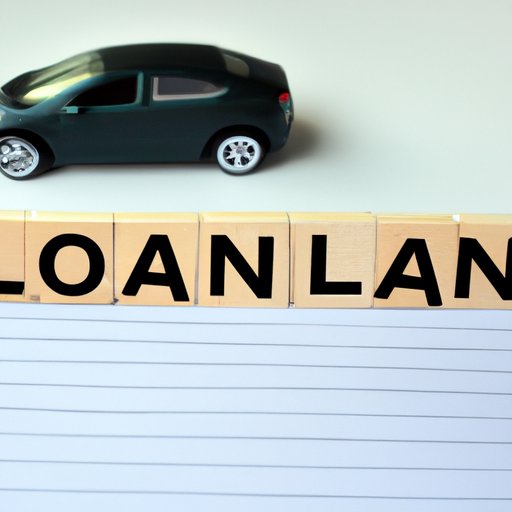
I. Introduction
Selling a car can be a complicated process, especially if you still have an outstanding auto loan on the car. It is essential to approach the situation carefully to ensure you get the best value for your car and avoid legal issues with the lender. In this article, we provide valuable insights into ways to sell a car with an outstanding auto loan.
II. 5 Tips for Selling Your Car With an Outstanding Loan
If you decide to sell your car with an outstanding loan, there are several ways to clear the outstanding loan. One approach is to use the proceeds of the sale to pay off the outstanding loan. If this isn’t feasible, you can also negotiate with the lender to see if they will allow you to pay off the remaining balance upon the sale of the car. Another option is to try refinancing the outstanding loan to decrease monthly payments and make it easier to sell your car.
Lenders can be flexible in these situations. Remember, they want their money, so they are usually willing to come to a mutually beneficial agreement when possible. Refinancing offers a couple of valuable advantages – you can potentially decrease your monthly payments, reducing financial stress and make the car more appealing. Ultimately, this might make selling the car easier.
III. Selling Your Car: How to Deal with Negative Equity on Your Loan
Negative equity takes place when you owe more money than what your car is worth. The issue arises when you head into the selling process, and you can’t raise the cash or refinance the loan to close the negative equity gap. This, unfortunately, limits the options you have available to you.
To tackle this, you have few choices: pay the balance with savings, negotiate the balance with the lender, or roll the negative equity into a new loan or lease. Remember, rolling negative equity into a new loan will imply you’re paying down debt for your previous vehicle using funds from your next vehicle. While this can be a solution, be sure to consider the downside of adding more money to your next vehicle, making it more difficult to sell.
IV. Maximizing Your Car’s Value When Selling with a Loan
Without a doubt, preparing your car should be a priority when putting it up for sale, even more so when you have an outstanding auto loan. To maximize your car’s value, you need to detail the car correctly, address any minor issues with the car, and have a comprehensive understanding of its value.
It’s wise to understand the market and industry trends, so you can make informed decisions about your car’s asking price. Consider having your car inspected by a qualified mechanic and obtain a report. This will provide potential buyers with reassurance of the car’s health, and fill any knowledge gaps you may have regarding the vehicle, positioning you to ask and receive a fair price.
V. Selling Your Car to a Private Party with an Outstanding Loan
While it can be challenging to sell a car privately with an outstanding auto loan, there are benefits to this approach. Selling to a private buyer allows you to get the best price possible on your car; however, it does come with added work and risk.
You’ll need to handle all the paperwork, including the title transfer and ensure the buyer is made aware of the outstanding auto loan, including any negative equity. Be sure to have all the facts ready when speaking with prospective buyers to facilitate negotiations. In summary, selling a car privately implies you’re willing to do more work, but the reward could be a better selling price for the car.
VI. Trading in Your Car with an Outstanding Loan: What to Know
One of the most convenient ways to sell your car is to trade it in, allowing you to sell the car and simultaneously buy a new one from a car dealer. Trading in a car with an outstanding auto loan can be a tricky process. You’ll need to factor in negative equity if you have negative equity in the car, indicating that you owe more than the car is currently worth.
Negotiating a trade-in with a dealer can be a good option if you need to deal with negative equity on a current loan. Be sure to negotiate a fair price on your trade-in and ensure the sales agreement clearly states how the trade-in’s negative equity has been treated. Keep in mind that dealers can try and manipulate how they value your trade-in to minimise their expenditure.
VII. Selling a Car with an Outstanding Auto Loan: The Pros and Cons of Each Option
Selling a car while you still have an outstanding auto loan provides you with a few options — there’s no perfect solution as each comes with pros and cons. Ultimately, the best option for you will depend on financial, emotional, and practical circumstances as well.
If you can make additional payments, you can work to pay off the loan faster. Refinancing your loan and making the car more presentable to buyers can make it easier to find a buyer. Trading in the car can take the effort out of selling, albeit with less of a financial reward. Selling a car privately has the chance to yield the best reward, but it may require more paperwork and communication.
VIII. Conclusion
Selling a car with an outstanding auto loan can be complicated, but it’s not impossible. It would be best if you approached the situation wisely by considering all your options, navigating negative equity and maximizing your car’s value when presenting it for sale. By doing so, you’ll increase your chances of a successful and profitable sale, and navigate costly legal issues that could impact your finances for years to come.




